Phosphorus Loss through Overland Flow and Interflow from Bare Weathered Granite Slopes in Southeast China
Abstract
1. Introduction
2. Materials and Methods
2.1. Study Area and Soil Sampling
2.2. Experimental Design and Sample Analysis
3. Results and Discussion
3.1. TP Loss through Overland Flow and Interflow
3.2. Average DP and PP Concentrations
3.3. Relationships between TP, DP and PP in Overland Flow and Interflow
4. Conclusions
Author Contributions
Funding
Acknowledgments
Conflicts of Interest
References
- Gao, Y.; Zhu, B.; Zhou, P.; Tang, J.; Wang, T.; Miao, C. Effects of vegetation cover on phosphorus loss from a hillslope cropland of purple soil under simulated rainfall: A case study in China. Nutr. Cycl. Agroecosys. 2009, 85, 263–273. [Google Scholar] [CrossRef]
- Zhang, R.; Li, M.; Yuan, X.; Pan, Z. Influence of rainfall intensity and slope on suspended solids and phosphorus losses in runoff. Environ. Sci. Pollut. Res. 2018, 26, 1–13. [Google Scholar] [CrossRef] [PubMed]
- Novais, S.V.; Olivieira-Zenero, M.D.; Carneiro-Barreto, M.S.; Montes, C.R.; Pelegrino-Cerri, C.E. Phosphorus removal from eutrophic water using modified biochar. Sci. Total Environ. 2018, 633, 825–835. [Google Scholar] [CrossRef] [PubMed]
- Yang, P.; Lai, D.Y.F.; Jin, B.; Bastviken, D.; Tan, L.; Tong, C. Dynamics of dissolved nutrients in the aquaculture shrimp ponds of the Min River estuary, China: Concentrations, fluxes and environmental loads. Sci. Total Environ. 2017, 603, 256–267. [Google Scholar] [CrossRef] [PubMed]
- Jeong, C.Y.; Weindorf, D.C.; DeRamus, A.; Goodeaux, L.L. Surface and subsurface phosphorus losses from sugarcane fields with different management practices. Water Air Soil Poll. 2011, 217, 649–661. [Google Scholar] [CrossRef]
- Zheng, J.; Li, F.; Sun, L. Identification of eutrophication-controlling factors in mesohalinous waters of coastal region: A case study on Qingjing Lake of Tianjin City. Acta Sci. Circumstantiae 2016, 36, 785–791. [Google Scholar] [CrossRef]
- Correll, D.L. The role of phosphorus in the eutrophication of receiving waters: A review. J. Environ. Qual. 1998, 27, 261–266. [Google Scholar] [CrossRef]
- Recanatesi, F.; Ripa, M.N.; Leone, A.; Luigi, P.; Luca, S. Land use, climate and transport of nutrients: Evidence emerging from the lake vicocase study. Environ. Manag. 2013, 52, 503–513. [Google Scholar] [CrossRef]
- Zheng, H.; Liu, Z.; Zuo, J.; Wang, L.; Nie, X. Characteristics of nitrogen loss through Surface-Subsurface flow on red soil slopes of southeast china. Eurasian Soil Sci. 2017, 50, 1506–1514. [Google Scholar] [CrossRef]
- Wu, X.; Wei, Y.; Wang, J.; Xia, J.; Cai, C.; Wu, L.; Fu, Z.; Wei, Z. Effects of erosion degree and rainfall intensity on erosion processes for Ultisols derived from quaternary red clay. Agric. Ecosyst. Environ. 2017, 249, 226–236. [Google Scholar] [CrossRef]
- Deng, L.; Fei, K.; Sun, T.; Zhang, L.; Fan, X.; Ni, L. Characteristics of runoff processes and nitrogen loss through overland flow and interflow from weathered granite slopes of Southeast China. J. Mt. Sci. Engl. 2019, 16, 1048–1064. [Google Scholar] [CrossRef]
- Fei, K.; Deng, L.; Zhang, L.; Sun, T.; Wu, Y.; Fan, X.; Dong, Y. Lateral transport of soil total carbon with slope runoff and interflow: Effects of rainstorm characteristics under simulated rainfall. Catena 2019, 179, 39–48. [Google Scholar] [CrossRef]
- Roberts, W.M.; Stutter, M.I.; Haygarth, P.M. Phosphorus retention and remobilization in vegetated buffer strips: A review. J. Environ. Qual. 2012, 41, 389–399. [Google Scholar] [CrossRef] [PubMed]
- Zhou, B.; Vogt, R.D.; Lu, X.; Yang, X.; Lu, C.; Mohr, C.W.; Zhu, L. Land use as an explanatory factor for potential phosphorus loss risk, assessed by P indices and their governing parameters. Environ. Sci. Proc. Imp. 2015, 17, 1443–1454. [Google Scholar] [CrossRef] [PubMed][Green Version]
- Chu, L.; Wang, K.; Song, Z.; Li, T.; Li, Y. Dynamics of nitrogen and phosphorus in tobacco slope cropland interflow. J. Agro Environ. Sci. 2010, 29, 1346–1354. [Google Scholar]
- Heathwaite, A.L.; Dils, R.M. Characterising phosphorus loss in surface and subsurface hydrological pathways. Sci. Total Environ. 2000, 251, 523–538. [Google Scholar] [CrossRef]
- Dupas, R.; Mellander, P.; Gascuel-Odoux, C.; Fovet, O.; McAleer, E.B.; McDonald, N.T.; Shore, M.; Jordan, P. The role of mobilisation and delivery processes on contrasting dissolved nitrogen and phosphorus exports in groundwater fed catchments. Sci. Total Environ. 2017, 599, 1275–1287. [Google Scholar] [CrossRef]
- Tuo, G.; Li, H.; Jin, Y.; Li, Y. Characteristics of phosphorus transfer in farmland under artificial rainfall conditions. Hupokexue 2009, 21, 45–52. [Google Scholar]
- Li, Z.; Zhang, G.; Yu, X.; Liu, Q.; Zhang, X. Phosphorus loss and its estimation in a small watershed of the Yimeng mountainous area, China. Environ. Earth Sci. 2015, 73, 1205–1216. [Google Scholar] [CrossRef]
- Wang, L.; Liang, T.; Zhang, Q. Laboratory experiments of phosphorus loss with surface runoff during simulated rainfall. Environ. Earth Sci. 2013, 70, 2839–2846. [Google Scholar] [CrossRef]
- Heclrath, G.; Brookes, P.C.; Poulton, P.R.; Goulding, K. Phosphorus leaching from soils containing different phosphorus concentrations in the broadbalk experiment. J. Environ. Qual. 1995, 24, 904–910. [Google Scholar] [CrossRef]
- Xie, S.; Mo, M.; Tu, A.; Liu, Y. Characteristics of vertical runoff output on red-soil slope under natural rainfall condition. Trans. Chin. Soc. Agric. Eng. 2014, 30, 132–138. [Google Scholar] [CrossRef]
- Fu, X.; Zhang, L.; Wang, X. The effect of slope length on sediment yield by rainfall impact under different land use types. Water Resour. 2016, 43, 478–485. [Google Scholar] [CrossRef]
- Tiwari, K.R.; Sitaula, B.K.; Bajracharya, R.M.; Borresen, T. Effects of soil and crop management practices on yields, income and nutrients losses from upland farming systems in the Middle Mountains region of Nepal. Nutr. Cycl. Agroecosys. 2010, 86, 241–253. [Google Scholar] [CrossRef]
- Zhang, Q.; Chen, S.; Dong, Y.; Liu, D.; Yang, X.; Yang, Z. Controllability of phosphorus losses in surface runoff from sloping farmland treated by agricultural practices. Land Degrad. Dev. 2017, 28, 1704–1716. [Google Scholar] [CrossRef]
- Chang, S.; Hu, X.; Shi, D.; Ding, W.; Jiang, P. Characteristics of runoff and sediment, nitrogen and phosphorus losses under soil management measures in sloping farmland. J. Soil Water Conserv. 2016, 30, 34–40. [Google Scholar] [CrossRef]
- Fan, X.; Zhang, L.; Deng, L.; Wu, Y.; Qian, J. Effects of vegetation coverage and fertilization on total phosphorus loss on slope land with different slope length. J. Soil Water Conserv. 2017, 31, 30–35. [Google Scholar] [CrossRef]
- Wu, L.; Qiao, S.; Peng, M.; Ma, X. Coupling loss characteristics of runoff-sediment-adsorbed and dissolved nitrogen and phosphorus on bare loess slope. Environ. Sci. Pollut. Res. 2018, 25, 14018–14031. [Google Scholar] [CrossRef]
- Xiao, Y.; Tang, J.; Wang, M.; Zhai, L.; Zhang, X. Impacts of soil properties on phosphorus adsorption and fractions in purple soils. J. Mt. Sci. Engl. 2017, 14, 2420–2431. [Google Scholar] [CrossRef]
- Liu, R.; Wang, J.; Shi, J.; Chen, Y.; Sun, C.; Zhang, P.; Shen, Z. Runoff characteristics and nutrient loss mechanism from plain farmland under simulated rainfall conditions. Sci. Total Environ. 2014, 468, 1069–1077. [Google Scholar] [CrossRef]
- Wei, Y.; Wu, X.; Cai, C. Splash erosion of clay–sand mixtures and its relationship with soil physical properties: The effects of particle size distribution on soil structure. Catena 2015, 135, 254–262. [Google Scholar] [CrossRef]
- Yang, L.; Yang, G.; Li, H.; Yuan, S. Effects of rainfall intensities on sediment loss and phosphorus enrichment ratio from typical land use type in Taihu Basin, China. Environ. Sci. Pollut. Res. 2019, 26, 1–8. [Google Scholar] [CrossRef]
- Barré, P.; Durand, H.; Chenu, C.; Meunier, P.; Montagne, D.; Castel, G.; Billiou, D.; Soucémarianadin, L.; Cécillon, L. Geological control of soil organic carbon and nitrogen stocks at the landscape scale. Geoderma 2017, 285, 50–56. [Google Scholar] [CrossRef]
- Bao, S. Soil and Agricultural Chemistry Analysis; China Agricultural Press: Beijing, China, 2000. [Google Scholar]
- Su, J.; Wang, H.; Kimberley, M.O.; Beecroft, K.; Magesan, G.N.; Hu, C. Fractionation and mobility of phosphorus in a sandy forest soil amended with biosolids. Environ. Sci. Pollut. Res. 2007, 14, 529–535. [Google Scholar] [CrossRef]
- Sun, Z.; Lotz, T.; Chang, N. Assessing the long-term effects of land use changes on runoff patterns and food production in a large lake watershed with policy implications. J. Environ. Manag. 2017, 204, 92–101. [Google Scholar] [CrossRef]
- Tang, J.; Zhu, B.; Wang, T.; Cheng, X.; Gao, M.; Lin, H. Suboverland flow processes in sloping cropland of purple soil. J. Mt. Sci. Engl. 2012, 9, 1–9. [Google Scholar] [CrossRef]
- Calvo-Cases, A.; Boix-Fayos, C.; Imeson, A.C. Runoff generation, sediment movement and soil water behaviour on calcareous (limestone) slopes of some Mediterranean environments in southeast Spain. Geomorphology 2003, 50, 269–291. [Google Scholar] [CrossRef]
- Deng, L.; Zhang, L.; Fan, X.; Wu, Y.; Sun, T.; Fei, K. Characteristics of runoff and sediment yield under different rainfall intensities and slope gradients in erosive weathered granite area. Trans. Chin. Soc. Agric. Eng. 2018, 34, 143–150. [Google Scholar] [CrossRef]
- Ribolzi, O.; Patin, J.; Bresson, L.M.; Latsachack, K.O.; Mouche, E.; Sengtaheuanghoung, O.; Silvera, N.; Thiebaux, J.P.; Valentin, C. Impact of slope on soil surface features and infiltration on steep slopes in northern Laos. Geomorphology 2011, 127, 53–63. [Google Scholar] [CrossRef]
- Shan, Y.; Yang, L.; Yan, T.; Wang, J. The variation of P & N contents in paddy soil water and its environmental effect. Acta Ecol. Sin. 2005, 25, 115–121. [Google Scholar] [CrossRef]
- Li, F.; Zhang, G.; Xu, Y. Spatiotemporal variability of climate and streamflow in the Songhua River Basin, northeast China. J. Hydrol. 2014, 514, 53–64. [Google Scholar] [CrossRef]
- Kong, G.; Wang, Q.; Fan, J. Research on nutrient loss from loessial soil under different slope. J. Soil Water Conserv. 2007, 21, 14–18. [Google Scholar] [CrossRef]
- Sharpley, A.N.; McDowell, R.W.; Kleinman, P. Phosphorus loss from land to water: Integrating agricultural and environmental management. Plant Soil 2001, 237, 287–307. [Google Scholar] [CrossRef]
- Tan, C.; Zhang, T. Surface runoff and sub-surface drainage phosphorus losses under regular free drainage and controlled drainage with sub-irrigation systems in southern Ontario. Can. J. Soil Sci. 2011, 91, 349–359. [Google Scholar] [CrossRef]
- Du, E.; Jackson, C.R.; Klaus, J.; McDonnell, J.J.; Griffiths, N.A.; Williamson, M.F.; Greco, J.L.; Bitew, M. Interflow dynamics on a low relief forested hillslope: Lots of fill, little spill. J. Hydrol. 2016, 534, 648–658. [Google Scholar] [CrossRef]
- He, S.; Gong, Y.; Zheng, Z. Phosphorus loss through interflow from sloping cropland of purple soil region. J. Soil Water Conserv. 2014, 28, 20–24. [Google Scholar] [CrossRef]
- Hu, Z.; Gao, M.; Xie, D.; Wang, Z. Phosphorus loss from dry sloping lands of three gorges reservoir area, China. Pedosphere 2013, 23, 385–394. [Google Scholar] [CrossRef]
- Wang, Y.; Zhang, T.; Hu, Q.; O’Halloran, I.P.; Tan, C.; Reid, K. Temporal patterns of soil phosphorus release to runoff during a rainfall event as influenced by soil properties and its effects on estimating soil P losses. Can. J. Soil Sci. 2011, 91, 339–347. [Google Scholar] [CrossRef]
- Wang, G.; Wu, B.; Zhang, L.; Jiang, H.; Xu, Z. Role of soil erodibility in affecting available nitrogen and phosphorus losses under simulated rainfall. J. Hydrol. 2014, 514, 180–191. [Google Scholar] [CrossRef]
- Dupas, R.; Gascuel-Odoux, C.; Gilliet, N.; Grimaldi, C.; Gruau, G. Distinct export dynamics for dissolved and particulate phosphorus reveal independent transport mechanisms in an arable headwater catchment. Hydrol. Process. 2015, 29, 3162–3178. [Google Scholar] [CrossRef]
- Doody, D.; Moles, R.; Tunney, H.; Kurz, I.; Bourke, D.; Daly, K.; O’Regan, B. Impact of flow path length and flow rate on phosphorus loss in simulated overland flow from a humic gleysol grassland soil. Sci. Total Environ. 2006, 372, 247–255. [Google Scholar] [CrossRef]
- Wang, C.; Zhao, P.; Gao, M. Characteristics of nitrogen and phosphorus transportation through runoff in a typical ecological-hydrological unit of hilly area of purple soil. J. Hydraul. Eng. 2013, 44, 748–755. [Google Scholar]
- Sharpley, A.N.; Robinson, J.S.; Smith, S.J. Bioavailable phosphorus dynamics in agricultural soils and effects on water-quality. Geoderma 1995, 67, 1–15. [Google Scholar] [CrossRef]
- Allaire, S.E.; Van-Bochove, E.; Denault, J.; Dadfar, H.; Theriault, G.; Charles, A.; De-Jong, R. Preferential pathways of phosphorus movement from agricultural land to water bodies in the Canadian Great Lakes basin: A predictive tool. Can. J. Soil Sci. 2011, 91, 361–374. [Google Scholar] [CrossRef]
- Simard, R.R.; Beauchemin, S.; Haygarth, P.M. Potential for preferential pathways of phosphorus transport. J. Environ. Qual. 2000, 29, 97–105. [Google Scholar] [CrossRef]
- Uusitalo, R.; Turtola, E.; Kauppila, T.; Lilja, T. Particulate phosphorus and sediment in surface runoff and drainflow from clayey soils. J. Environ. Qual. 2001, 30, 589–595. [Google Scholar] [CrossRef]
- Zhang, T.; Tan, C.; Zheng, Z.; Drury, C.F. Tile drainage phosphorus loss with Long-Term consistent cropping systems and fertilization. J. Environ. Qual. 2015, 44, 503–511. [Google Scholar] [CrossRef]
- Shore, M.; Jordan, P.; Mellander, P.E.; Kelly-Quinn, M.; Wall, D.P.; Murphy, P.N.C.; Melland, A.R. Evaluating the critical source area concept of phosphorus loss from soils to water-bodies in agricultural catchments. Sci. Total Environ. 2014, 490, 405–415. [Google Scholar] [CrossRef]

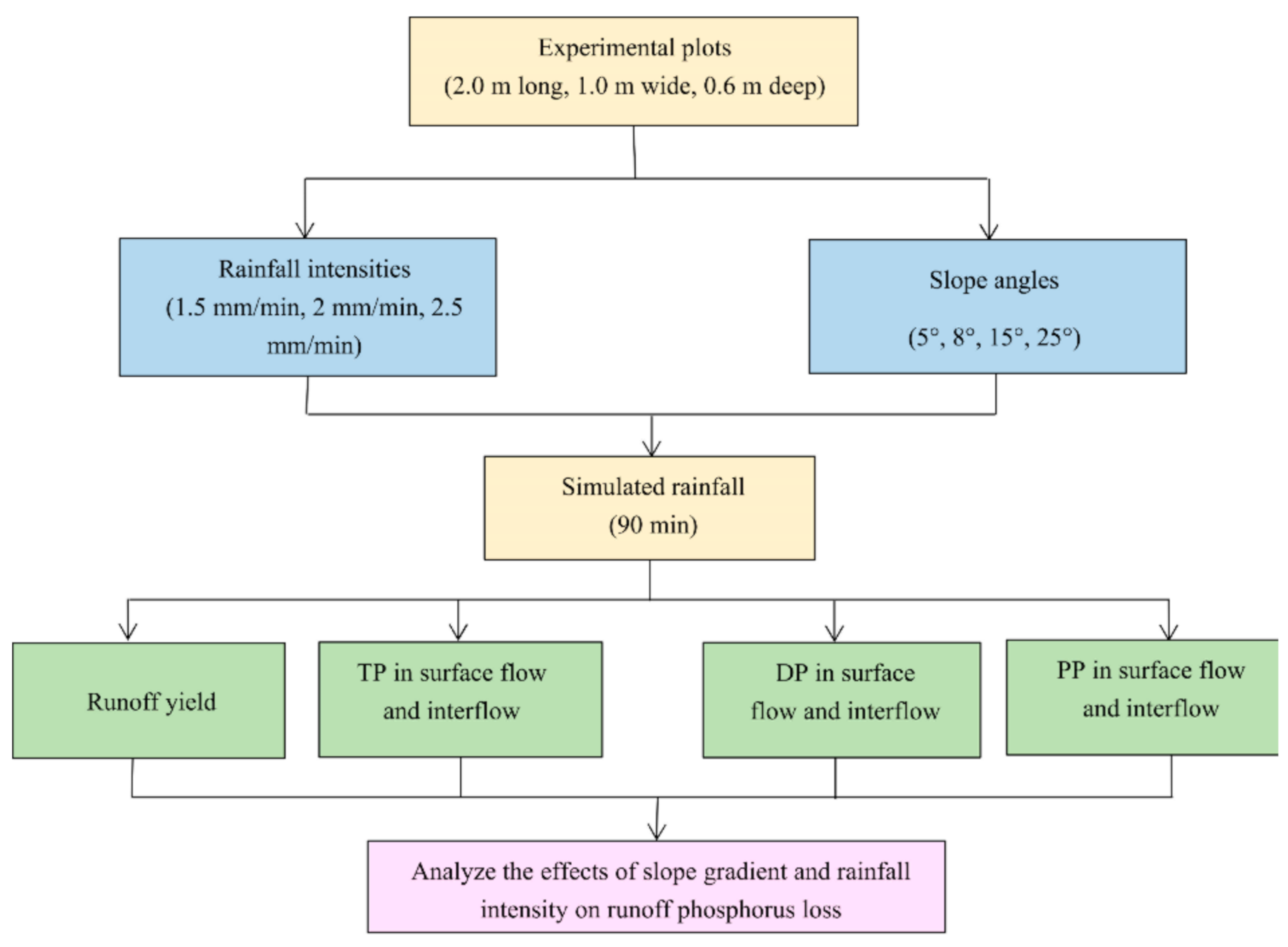
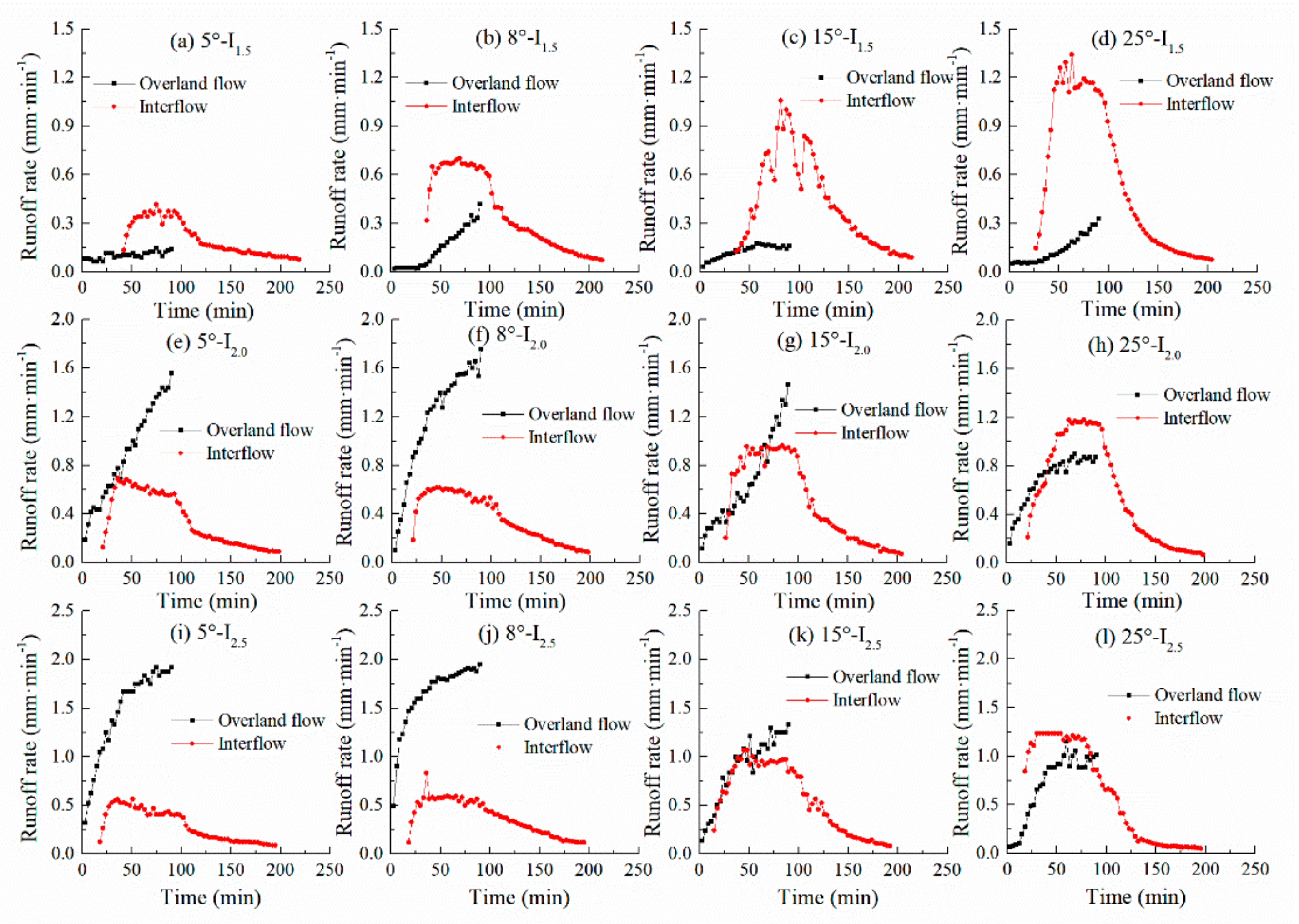
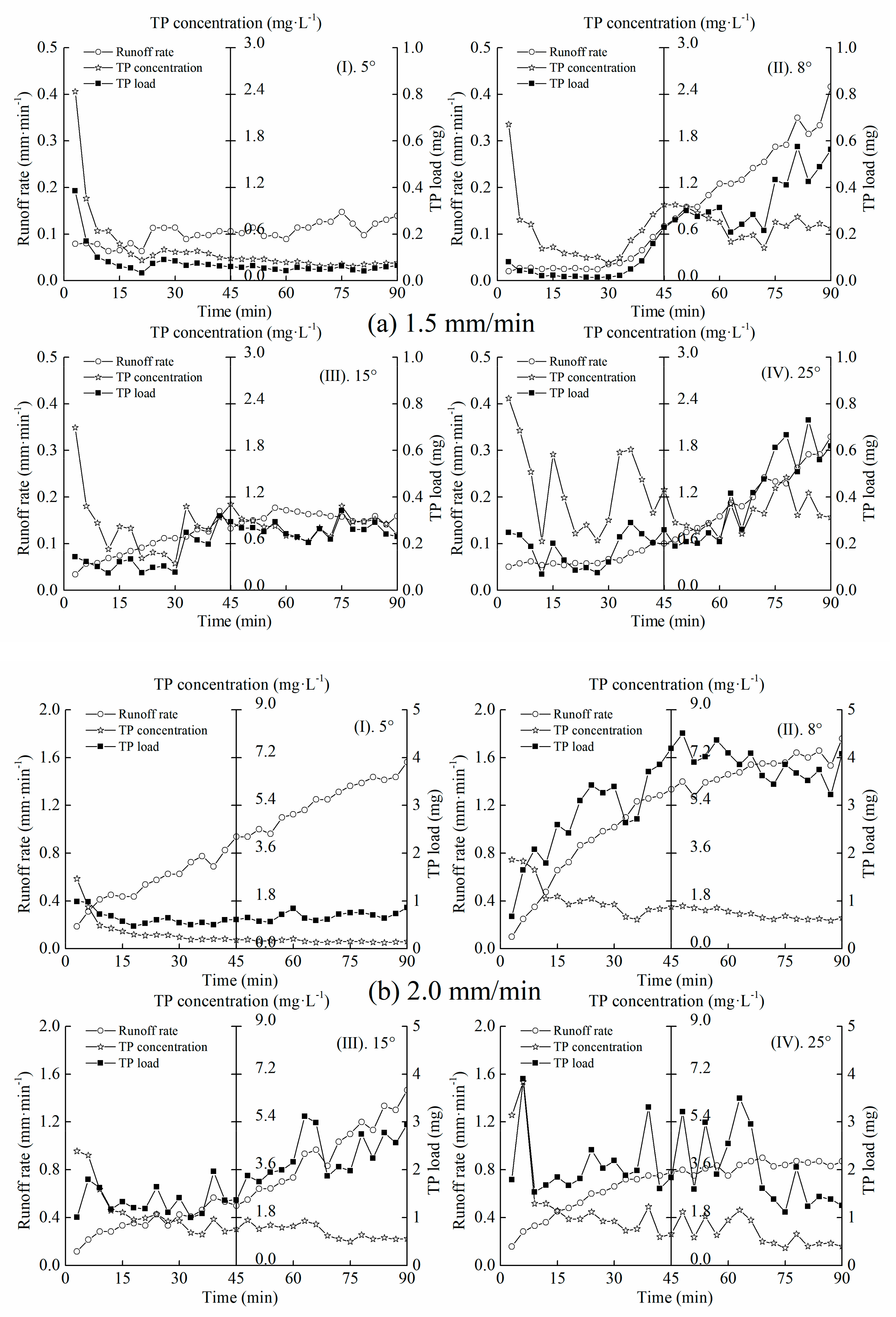


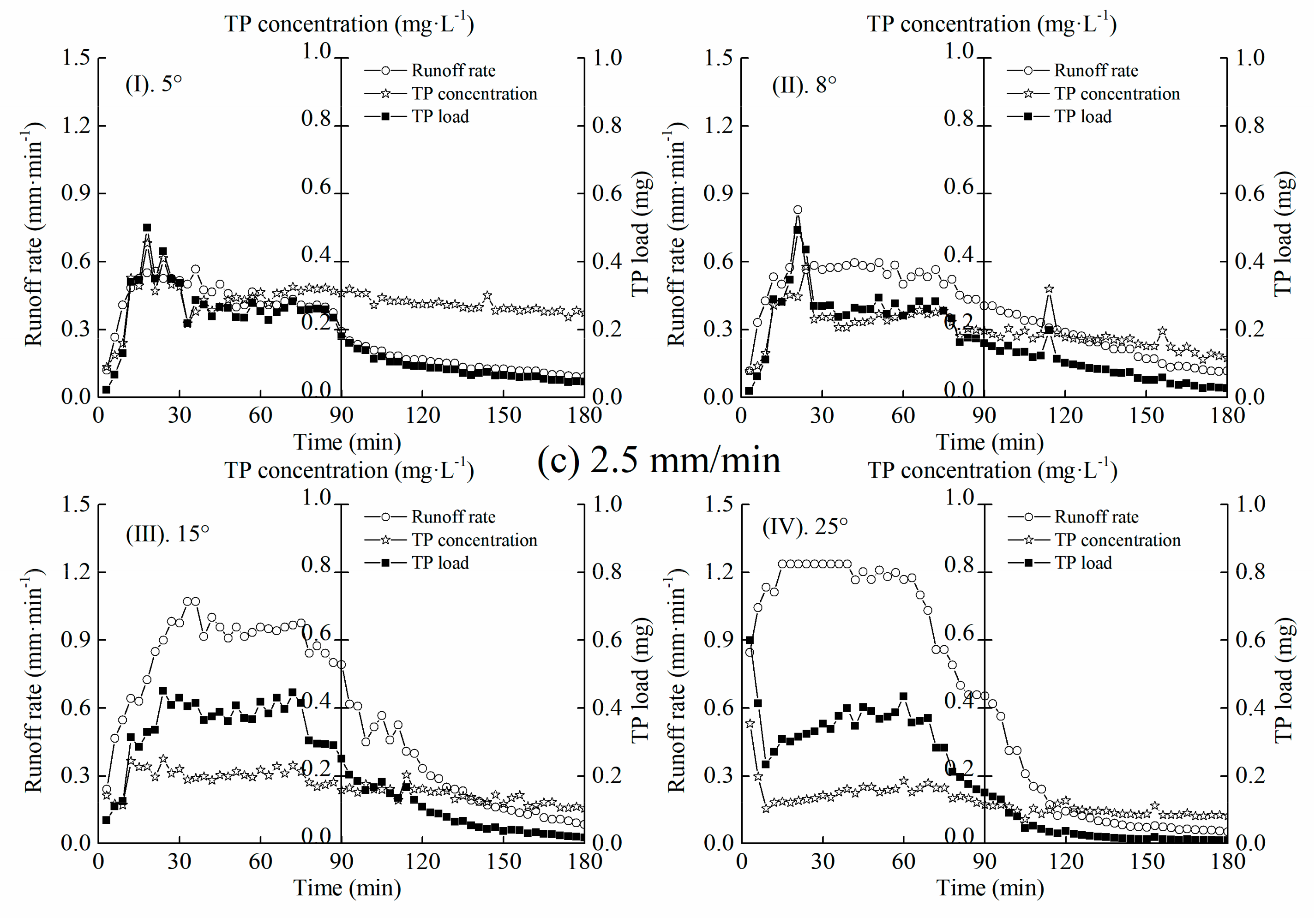

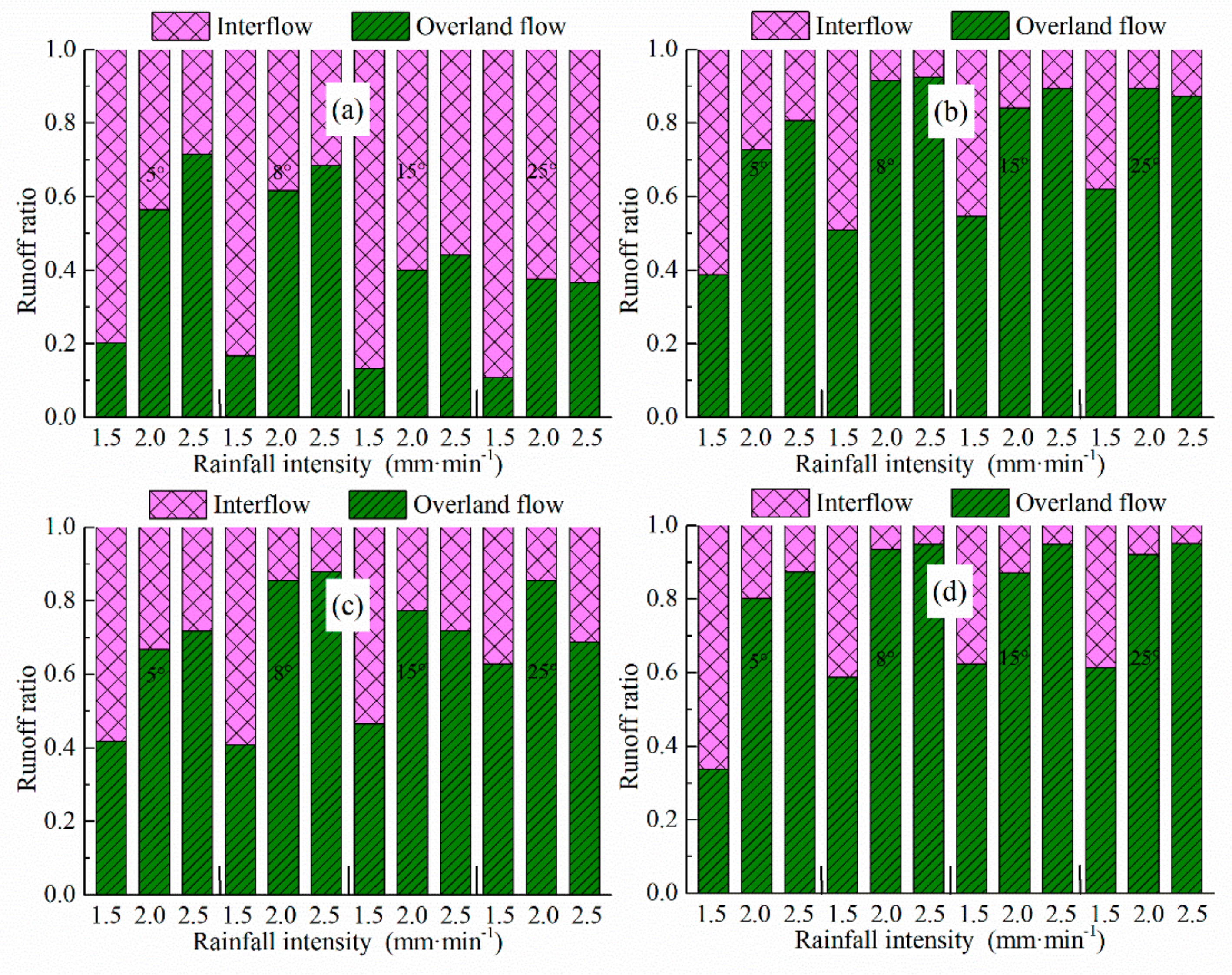
| LTP | LDP | LPP | Q | I | S | |
|---|---|---|---|---|---|---|
| LTP | 1 | 0.913 ** | 0.989 ** | 0.765 ** | 0.800 ** | 0.069 |
| LDP | 0.894 ** | 1 | 0.844 ** | 0.845 ** | 0.775 ** | 0.031 |
| LPP | 0.734 ** | 0.353 | 1 | 0.704 * | 0.775 ** | 0.080 |
| Q | 0.410 | 0.374 | 0.29 | 1 | 0.844 ** | −0.320 |
| I | 0.905 ** | 0.927 ** | 0.486 | 0.251 | 1 | 0 |
| S | 0.080 | 0.093 | 0.026 | 0.909 ** | 0 | 1 |
© 2019 by the authors. Licensee MDPI, Basel, Switzerland. This article is an open access article distributed under the terms and conditions of the Creative Commons Attribution (CC BY) license (http://creativecommons.org/licenses/by/4.0/).
Share and Cite
Deng, L.; Fei, K.; Sun, T.; Zhang, L.; Fan, X.; Ni, L. Phosphorus Loss through Overland Flow and Interflow from Bare Weathered Granite Slopes in Southeast China. Sustainability 2019, 11, 4644. https://doi.org/10.3390/su11174644
Deng L, Fei K, Sun T, Zhang L, Fan X, Ni L. Phosphorus Loss through Overland Flow and Interflow from Bare Weathered Granite Slopes in Southeast China. Sustainability. 2019; 11(17):4644. https://doi.org/10.3390/su11174644
Chicago/Turabian StyleDeng, Longzhou, Kai Fei, Tianyu Sun, Liping Zhang, Xiaojuan Fan, and Liang Ni. 2019. "Phosphorus Loss through Overland Flow and Interflow from Bare Weathered Granite Slopes in Southeast China" Sustainability 11, no. 17: 4644. https://doi.org/10.3390/su11174644
APA StyleDeng, L., Fei, K., Sun, T., Zhang, L., Fan, X., & Ni, L. (2019). Phosphorus Loss through Overland Flow and Interflow from Bare Weathered Granite Slopes in Southeast China. Sustainability, 11(17), 4644. https://doi.org/10.3390/su11174644





